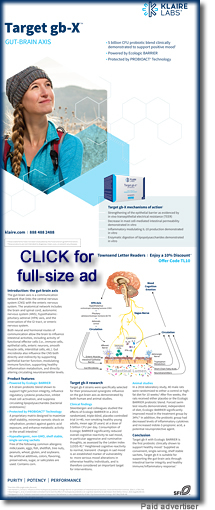|
Imbalances in the skin microbiome play a key role in skin disorders; and while most microbiome research to date has been focused on the gastrointestinal tract, more research is being revealed about the cutaneous microbiome and its important role in maintaining skin health. Both internal and external factors are at play in the skin microbiome and dysbiosis. More research is unfolding about these connections, which can point to a new way of looking at dermatologic conditions and how we can transform the cutaneous microbiota to address inflammatory conditions such as acne, atopic dermatitis, rosacea, and premature aging.
 It is estimated that human skin is inhabited by approximately one million bacteria/cm,1 and, the microbiota varies around different areas of the body as well as amongst different individuals. Lifestyle, environment, hygiene, diet, age, and sex all greatly impact the makeup of the skin microbiome.2 It's interesting to consider the various lifestyle factors and hygiene practices that have changed over the last few decades and how they have contributed to the high rates of acne, atopic dermatitis and other inflammatory skin disorders. The germ-phobia trend in Western cultures has altered our microbiota in various areas of the human body, and the skin is not immune to this impact. It is estimated that human skin is inhabited by approximately one million bacteria/cm,1 and, the microbiota varies around different areas of the body as well as amongst different individuals. Lifestyle, environment, hygiene, diet, age, and sex all greatly impact the makeup of the skin microbiome.2 It's interesting to consider the various lifestyle factors and hygiene practices that have changed over the last few decades and how they have contributed to the high rates of acne, atopic dermatitis and other inflammatory skin disorders. The germ-phobia trend in Western cultures has altered our microbiota in various areas of the human body, and the skin is not immune to this impact.
The skin microbiome is also impacted by where individuals live and with whom they live. People who live in rural areas have greater diversity than those living in urban environments,3 and people in the same household can impact each other's skin microbiomes.4 This puts even greater emphasis on the idea that when treating an individual, it may be particularly important to look at the home environment and the health and practices of their co-habitants, including pets in the home.
Research shows that commensal skin microbiota (Staphyloccocus epidermidis) influence skin immunity and limit pathogen invasion by inducing specialized T cells to move to the epidermis.5 This indicates the importance of maintaining a balanced skin microbiome to protect the skin from disease.
And the internal connection with the gut is key as well. Due to research on the gut-brain-skin axis, we're discovering more about the connection between stress, anxiety, and depression with changes in the gut microbiota and leaky gut, which creates can trigger inflammatory dermatologic issues, such as acne.6,7 Knowing this helps us draw the connection between addressing gut dysbiosis and permeability and how it, in turn, has the potential to improve the skin microbiota. For years, naturopathic physicians have drawn the connection between digestive health and the skin, so this is not a new concept. However, it is nice to see the research supporting the correlation.
 Superficially, an important factor in supporting the skin microbiota involves the pH of the skin. The external pH of human skin has a natural pH level of about 4.5 pH.8This mildly acidic environment helps keep the skin's microbiota in balance. On the other hand, a more alkaline pH (around 8 to 9) can disrupt the microbiota. Superficially, an important factor in supporting the skin microbiota involves the pH of the skin. The external pH of human skin has a natural pH level of about 4.5 pH.8This mildly acidic environment helps keep the skin's microbiota in balance. On the other hand, a more alkaline pH (around 8 to 9) can disrupt the microbiota.
Considering water has a pH of 7, it is too alkaline for optimizing skin pH. After rinsing with water, a more optimal cutaneous pH can be supported by using skincare products in the 4.5-5.0 pH range. Many common skincare products, including soaps, cleansers, masks, moisturizers, and over-the-counter topical medications have a pH of 5.5 and higher, which can make the skin more prone to infections and premature aging.9
A common approach by natural or holistic-minded individuals to topical skincare is that less is more. People will sometimes minimize their skincare routine to reduce exposure to toxic skincare ingredients, so they resort to simplifying their skincare to water, bars of soap, and natural oils such as coconut oil. Unfortunately, this approach does not actually promote an optimal skin microbiome. It does help reduce exposure to known endocrine disruptors such as parabens and di-ethyl phthalate (found in fragrance), but it does not support the mild acidity of the skin, which, in turn, supports the skin microbiome.
In healthy individuals without chronic skin concerns, their skin's acidic mantle will likely rebalance and restore the skin after the use of more neutral or alkaline product applications on the skin. But, if we're looking at individuals with dermatologic skin disorders whose skin microbiome is already disrupted, it is unlikely their skin will be able to rebalance as easily. Instead, supporting the individual's skin with skincare and topical treatments in the ideal pH range may support their recover from inflammatory skin conditions more rapidly.
When looking for skincare products and topical treatments with the 4.5-5.0 pH range, there are a few things to consider. Skincare companies generally do not list the pH of their products on the label, but they should have that information when you contact the manufacturer. When looking at labels, you can identify certain ingredients that indicate a lower pH, such as hyaluronic acid, alpha hydroxy acids, amino fruit acids and retinoic acids. At the same time, skincare products with too low of a pH can also disrupt the skin's natural barrier and irritate the skin, so the formulations need to include other ingredients to ensure the ideal pH range. In addition to ingredients with a low pH, there are others that naturally support the acid mantle, such as argan kernel oil.
In addition to the pH of products, other aspects of topical products can significantly impact the skin microbiota. Antibacterial agents such as tricolan and topical antibiotics, for example, can disrupt the microbiota balance. Deodorant and anti-perspirant has been shown to increase Actinobacteria, therefore modifying the microbiota and leading to an overgrowth of odor-producing bacteria.10
The natural inclination is to consider topical probiotics to support the skin microbiome, and the research shows some positive movement in this direction. Probiotics applied topically appear to adhere to human keratin and prevent biofilm formation.11 Research shows that topical products containing prebiotics and/or probiotics may help skin by modulating the immune system and may provide therapeutic benefits for atopic diseases.12
Certain topical probiotic formulations have the potential to prevent skin dysbiosis, stimulate the activity and growth of beneficial microbiota, and improve skin barrier function.12 This is particularly important for dermatologic conditions with dry, sensitive, and reactive skin. It is also something to consider after individuals are exposed to invasive cosmetic procedures or overzealous hygienic routines, as well as after using medications such as antibiotics and corticosteroids.
At the same time, with 1 million bacteria on the skin and variability in microbiota in moist, sebaceous and dry areas as well as between individuals, more research is needed to determine the exact strains of probiotics that will be the most therapeutic for various dermatologic conditions. We can't assume that commensal bacteria residing on skin of healthy individuals is going to be therapeutic in individuals with impaired skin immune function and disease. Until there is more information on testing for and treatment using specific strains of microorganisms, we can focus on the tools we currently have to support balanced microbiota.
This means, supporting the gut microbiome with a fiber-rich diet and including foods containing active cultures such as fermented vegetables. Laboratory testing to identify gut dysbiosis issues can help direct the appropriate treatment such as with oral probiotics. In addition, using a skincare regime with a pH range of 4.5-5.0 can topically support the skin barrier function and acid mantle. Compounded topical treatments to address skin dysbiosis may also help treat certain skin conditions. With time, research and experience, more supportive treatments will be unveiled that will balance the skin microbiota to treat inflammatory dermatologic conditions.
References
1. Grice EA et al. Topographical and temporal diversity of the human skin microbiome. Science 2009; 324: 1, 190-1, 192.
2. Rodrigues H. The cutaneous ecosystem: the roles of the skin microbiome in health and its association with inflammatory skin conditions in humans and animals. Vet Dermatol. 2017;28(1):60-e15.
3. Hanski I, et al. Environmental biodiversity, human microbiota, and allergy are interrelated. Proc Natl Acad Sci USA. 2012; 109(21),8334-339.
4. Song SJ, et al. Cohabiting family members share microbiota with one another and with their dogs. Elife 2013; 2: e00458.
5. Naik S, et al. Commensal–dendritic-cell interaction specifies a unique protective skin immune signature. Nature. 2015;520(7545):104-108.
6. Arck, P, et al. Is there a 'gut–brain–skin axis'?. Experimental Dermatology. 2010;19: 401–405.
7. Bowe W, Pate NB, Logan AC. Acne vulgaris, probiotics and the gut-brain-skin axis: from anecdote to translational medicine. Benef Microbes. 2014;5(2):185–199.
8. Lambers H, et al. Natural skin surface pH is on average below 5, which is beneficial for its resident flora. Int J Cosmet Sci. 2006;28(5):359-70.
9. Jung YC, Kim EJ, et al. Effect of skin pH for wrinkle formation on Asian: Korean, Vietnamese and Singaporean. J Eur Acad Dermatol Venereol. 2013;27(3):e328-32.
10. Callewaert C, et al. Deodorants and antiperspirants affect the axillary bacterial community. Arch Dermatol Res. 2014;306(8):701-10.
11. Lopes EG, et al. Topical application of probiotics in skin: adhesion, antimicrobial and antibiofilm in vitro assays. J Appl Microbiol. 2017;122(2):450–461.
12. Al-Ghazzewi FH, Tester RF. Impact of prebiotics and probiotics on skin health. Benef Microbes. 2014;5(2):99–107.
 Dr. Trevor Cates graduated from the National College of Natural Medicine in 2000 and was the first woman licensed as a naturopathic doctor in the state of California. She was appointed by former Governor Arnold Schwarzenegger to California's Bureau of Naturopathic Medicine Advisory Council. She has worked with world-renowned spas and sees patients from around the world from her Park City, Utah, base. Her book Clean Skin from Within was an Amazon #1 bestseller in skin ailments for months after its release in 2017. She has her own PBS Special Younger Skin from Within and is host of The Spa Dr. Podcast. Dr. Cates' "The Spa Dr." skincare line is formulated with the ideal pH and plant-based organic ingredients designed to help individuals achieve vibrantly healthy skin. www.TheSpaDr.com. Dr. Trevor Cates graduated from the National College of Natural Medicine in 2000 and was the first woman licensed as a naturopathic doctor in the state of California. She was appointed by former Governor Arnold Schwarzenegger to California's Bureau of Naturopathic Medicine Advisory Council. She has worked with world-renowned spas and sees patients from around the world from her Park City, Utah, base. Her book Clean Skin from Within was an Amazon #1 bestseller in skin ailments for months after its release in 2017. She has her own PBS Special Younger Skin from Within and is host of The Spa Dr. Podcast. Dr. Cates' "The Spa Dr." skincare line is formulated with the ideal pH and plant-based organic ingredients designed to help individuals achieve vibrantly healthy skin. www.TheSpaDr.com.
|
![]()
![]()
![]()
![]()








 Dr. Trevor Cates graduated from the National College of Natural Medicine in 2000 and was the first woman licensed as a naturopathic doctor in the state of California. She was appointed by former Governor Arnold Schwarzenegger to California's Bureau of Naturopathic Medicine Advisory Council. She has worked with world-renowned spas and sees patients from around the world from her Park City, Utah, base. Her book
Dr. Trevor Cates graduated from the National College of Natural Medicine in 2000 and was the first woman licensed as a naturopathic doctor in the state of California. She was appointed by former Governor Arnold Schwarzenegger to California's Bureau of Naturopathic Medicine Advisory Council. She has worked with world-renowned spas and sees patients from around the world from her Park City, Utah, base. Her book